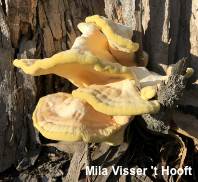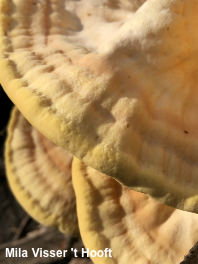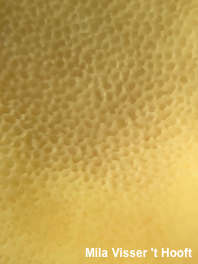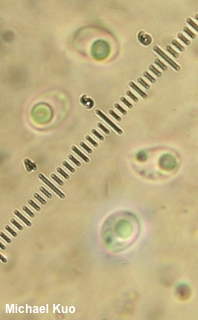| Major Groups > Polypores > Laetiporus > Laetiporus gilbertsonii |

|
Laetiporus gilbertsonii [ Basidiomycota > Polyporales > Laetiporaceae > Laetiporus . . . ] by Michael Kuo Found in southwestern and western North America, especially on the West Coast, this version of Laetiporus sulphureus appears on the wood of oaks and eucalyptus and features a yellow pore surface. This combination of details (western, hardwoods, yellow pore surface) is all you will need to separate Laetiporus gilbertsonii from other species of Laetiporus—although you are welcome to try mating it with other Laetiporus species and peeking at its DNA in order to reach the same conclusion; Laetiporus gilbertsonii has its species-concept bases covered, since it is a morphological species, a biological species, and a phylogenetic species. A variety with a white pore surface, Laetiporus gilbertsonii var. pallidus, appears on oaks and eucalyptus along the Gulf Coast of the United States (and probably Mexico). It is otherwise identical. Thanks to Mila Visser 't Hooft for documenting, collecting, and preserving Laetiporus gilbertsonii for study; her collection is deposited in The Herbarium of Michael Kuo. Description: Ecology: Parasitic and saprobic on living and dead oaks and eucalyptus trees; causing a brown rot of the heartwood; growing alone or gregariously on wood above the ground; fall and winter; distributed along the West Coast and in the southwestern United States, as well as western Mexico. The illustrated and described collection is from California. Fruiting Body: Up to 20 cm across; usually consisting of several to many shelving caps. Caps: 6–14 cm across; 4–10 cm deep; up to 2 cm thick; fan-shaped to semicircular; finely suedelike; bright to pale yellow or orangish yellow, with concentric bands of alternating shades of color; fading in maturity and with direct sunlight; the margin bright yellow when fresh whitish. Pore Surface: Yellow; not bruising; with 2–3 circular to angular pores per mm; tubes to 5 mm deep. Stem: Usually absent; when present poorly defined, yellowish, and tough. Flesh: Thick; soft and watery when young, becoming chalky with age; yellowish to whitish; not changing when sliced. Odor and Taste: Not distinctive. Microscopic Features: Spores 4–6 x 3–4 µm; broadly ellipsoid; smooth; hyaline in KOH; inamyloid. Hymenial cystidia not found. Hyphal system dimitic. Contextual binding hyphae 5–15 µm wide; often branching; aseptate; smooth; walls 0.5–1.5 µm thick; hyaline in KOH. Hymenial trama generative hyphae 3.5–4.5 µm wide; tubular and unbranched; usually parallel; septate; smooth; thin-walled; hyaline in KOH. Clamp connections not found. REFERENCES: Burdsall, 2001. (Banik & Burdsall, 2000; Burdsall & Banik, 2001; Lindner & Banik, 2008; Banik et al., 2010; Desjardin, Wood & Stevens, 2015; Siegel & Schwarz, 2016; Song & Cui, 2017.) Herb. Kuo 11151902. This site contains no information about the edibility or toxicity of mushrooms. |
© MushroomExpert.Com |
|
Cite this page as: Kuo, M. (2019, December). Laetiporus gilbertsonii. Retrieved from the MushroomExpert.Com Web site: http://www.mushroomexpert.com/laetiporus_gilbertsonii.html |



